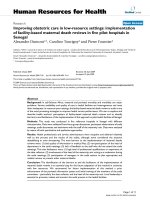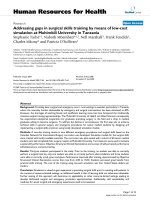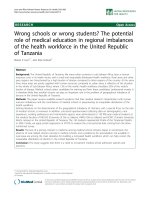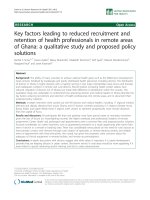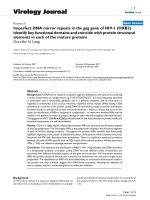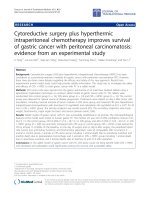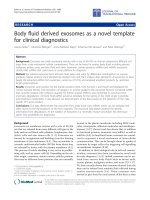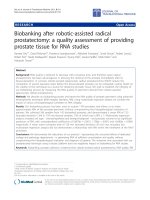Báo cáo sinh học: "Biobanking after robotic-assisted radical prostatectomy: a quality assessment of providing prostate tissue for RNA studies" doc
Bạn đang xem bản rút gọn của tài liệu. Xem và tải ngay bản đầy đủ của tài liệu tại đây (767.32 KB, 9 trang )
RESEARCH Open Access
Biobanking after robotic-assisted radical
prostatectomy: a quality assessment of providing
prostate tissue for RNA studies
Harveer Dev
1†
, David Rickman
2†
, Prasanna Sooriakumaran
1
, Abhishek Srivastava
1
, Sonal Grover
1
, Robert Leung
1
,
Robert Kim
2
, Naoki Kitabayashi
2
, Raquel Esqueva
2
, Kyung Park
2
, Jessica Padilla
2
, Mark Rubin
2
and
Ashutosh Tewari
1*
Abstract
Background: RNA quality is believed to decrease with ischaemia time, and therefore open radical
prostatectomy has been advantageous in allowing the r etrieval of the prostate immediately after its
devascularization. In contrast, robotic-assisted laparoscopic radical prostatectomies (RALP) require the
completion of several operative steps before the devascularized prostate can be extirpated, casting doubt on
the validity of this technique a s a source for obtaining prostatic tissue. We seek to establish the integrity of
our biobanking process by mea suring the RNA quality of specimens derived from robotic-assisted
laparoscopic radical prostatectomy.
Methods: We describe our biobanking process and report the RNA quality of prostate specimens using advanced
electrophoretic techniques (RNA Integrity Numbers, RIN). Using multivariate regression analysis we consider the
impact of various clinicopathological correlate s on RNA integrity.
Results: Our biobanking process has been used to acquire 1709 prostates, and allows us to retain
approximately 40% of the prostate specimen, without compromising t he histopathological evaluation of
patients. We collected 186 samples from 142 biobanked prostates, and demonstrated a mean RIN of 7.25
(standard deviation 1.64) in 139 non-stromal samples, 73% of which had a RIN ≥ 7. Multivariate regression
analysis revealed cell type - stromal/epithelial and benign/malignant - and prostate volume to be significant
predictors of RIN, with unstandardized coefficients of 0.867(p = 0.001), 1.738(p < 0.001) and -0.690(p = 0.009)
respectively. A mean warm ischaemia time of 120 min (standard deviation 30 min) was recorded, but
multivariate regression ana lysis did not demonstrate a relatio nship with RIN within the timeframe of the RALP
procedure.
Conclusions: We demonstrate the robustness of our protocol - representing the concerted efforts of dedicated
urology and pathology departments - in generating RNA of sufficient concentration and quality, without
compromising the histopathologica l evaluation and diagnosis of patients. The ischaemia time associated with our
prostatectomy technique using a robotic platform does not negatively impact on biobanking for RNA studies.
Keywords: biobanking, prostate collection, ischaemia time, robotic-assisted radical prostatectomy, RNA quality, RIN
* Correspondence:
† Contributed equally
1
Lefrak Center of Robotic Surgery & Institute for Prostate Cancer, Brady
Foundation Department of Urology, Weill Cornell Medical College, New York,
NY, USA
Full list of author information is available at the end of the article
Dev et al. Journal of Translational Medicine 2011, 9:121
/>© 2011 Dev et al; licensee BioMed Central Ltd. This is an Open Access articl e distributed under the terms of the Creative Commons
Attribution License ( which permits unrestricted use, distribution, and reproduction in
any medium, provide d the original work is properly cited.
Introduction
Prostate cancer remains the most common non-derma-
tological malignancy in men in the Western world [1].
As our knowledge of prostate cancer continues to be
driven by genomic studies, the accumulation of high
quality tissue within established biobanks becomes
increasingly important. High-throughput cDNA micro-
arrays are being used to map gene expression profiles in
prostate tissue, leading the way for improved disease
classifications, prognostic indicators, and therapeutic
targets via a greater understanding of the pathogenesis
of prostate cancer [2]. In order to draw meaningful con-
clusions from these transcriptomes, investigators must
possess robust methods for tissue biobanking , as well as
regularly perform quality control on the samples they
collect. Variations in both biobanking protocols and
quality control methods can limit comparisons between
different research groups, and hence the veracity of any
conclusions drawn from their molecular profiles.
The last ten years has witnessed significant advances
in radical prostatectomy, with the incorporation of
robotic platforms into the procedure. Robotic-assisted
laparoscopic radical prostatectomy (RALP) has become
the most widespread treatment for organ-c onfined pros-
tate cancer, currently accounting for more than 7 5% of
all radical prostatectomies performed in the USA [3].
The technique aims to minimize patient morbidity and
improve convalescence while delivering high standards
of oncological and functional control [4]. One inevitable
consequence of this transition has been the impact of
RALP on specimen collection. Once the prostate has
been freed from all its anatomical attachments, it
remains within the body until later steps of the opera-
tion (including the vesico-urethral anastomosis) have
been compl eted. Conc ern has surrounded the impact of
warm ischaemia on the integrity of prostate samples
that are subsequently banked and used for genetic ana-
lysis. Few studies have reported th e RNA quality of
prostate cancer samples derived from RALP, and of
these, small sample sizes of specimens may poten tially
limit their reproducibility [5,6].
Different methods of assessing RNA quality have
further complicated efforts to ensure consistency
between biobanks. Spectroscopic techniques compare
the absorbance of 260 nm and 280 nm ultraviolet light
by nucleic acids and proteins respectively. This so-called
ratios method of assessing RNA quantity and purity has
been shown to be ambiguous when compared to subjec-
tive expert evaluations of microcapillary electrophoretic
traces [7,8]. In order to standardize the process of inter-
preting RNA quality, Agilent Technologies (Santa Clara,
CA) have developed the RNA Integrity Number (RIN) -
a software algorithm whi ch allows for the classification
of total RNA, based on a numbering system from 1
(most degraded) to 10 (intact) [ 9]. Using the Agilent
2100 Bioanalyser and lab-on-chip microfluids technol-
ogy, software is able to generate an electropherogram;
the RIN algorithm then generates its integrity number
by taking into account the entire trace. This removes
any user-dependence which can often limit manual
methods, and hence allows the direct comparison of
specimen RNA quality between different institutions.
The advantages of RIN over other analytical methods
have been supported by several groups [8,10], and it has
subsequently become widely employed in studies which
seek to establish RNA quality [6,11-13].
In addition to the effect of warm ischaemia, other
clinicopathological correlates of RNA quality may be
considered. Prostates have been shown to be exquisitely
sensitive to intraoperative manipulation, showing
changes in gene expression well before devascularization
of the prostate [14,15]. It has also been suggested that
the histological properties of a sample, and its location
within a specimen, may influence the quality of RNA
obtained [11].
In this paper, we report the methodology of tissue col-
lection in our RALP prosta te cancer bioba nk involving
1709 radical prostatectom y specimens. We vali date the
robotic prostatectomy procedure as a reliable source for
prostat e cancer tissue coll ecti on, using RIN values from
more than 140 specimens, and consider the effects of
various clinicopathological variables on specimen
quality.
Materials and methods
Ethical approval and patient consent
An Institutional Review Board-approved research proto-
col was obtained in November 2006 for the collectio n of
prostate samples after robotic prostatectomy for the
treatment of clinically localized prostate cancer. Consent
was obtained from each patient p rior to them entering
surgery, following a detailed review of the patient con-
sent form.
Tissue collection
In order to ensure c onsistency, all p rostates within the
RALP prostate cancer biobank were derived entirely
from our institution, led by a single surgeon (AT), and
using our previously reported technique of RALP [4].
The prostates were extirpated within an EndoCatch bag,
before being assessed by the console surgeon or trained
assistants. The specimens were then transported by the
roboti c team to the pathology department without delay
(and hence overcoming the need for temporary ice sto-
rage), where they were received by a technician for
immediate preparation.
Dev et al. Journal of Translational Medicine 2011, 9:121
/>Page 2 of 9
Specimen preparation
The prostate was weighed, orientated, and marked in
black and green ink for the left and right sides respec-
tively. Margin analysis was initially performed from tis-
sue cassettes containing seminal vesicles and vasa
deferentia, the apex (distal urethral margin), and the
bladder neck (proximal urethral margin). Serial sections
of the prostate, perpendicular t o the urethra and mea-
suring 5 mm in thickness, were then taken from the
bladder base to the apex, and alp habetically labeled (e.g.
A to H). Each section was subsequently quartered or
divided into six equal parts (depending on the prostate
size), for placement into individual cassettes. Alternate
sections(e.g.A,C,EandG)and‘margin’ samples were
then formalin-fixed for routine histopathological diagno-
sis by immersing the tissue in 10% neutr al buffered for-
malin for between 4 and 24 hours, before being
processed and embedded in paraffin. The remaining
alternate prostate sections (i.e. B, D, F and H) were then
coated in Optimal Cutting Temperature (OCT) media
(Sakura Finetek, Torrance, CA), prior to snap freezing
in liquid nitrogen and storage in a plastic specimen bag
at -80°C in our tissue laboratory. The process of speci-
men collection is illustrated in Figure 1 and a photo-
graph exemplifying the samples collected from a
prostate specimen is presented in Figure 2.
Histological characterization of banked specimens
Following the establishment of the RALP prostate can-
cer biobank in February 2007, a Haematoxylin & Eosin
stained microscopic slide was prospectively prepared for
each banked tissue sample, prior to snap freezing of the
prost ate sections. The percentage of epithelial cells pre-
sent within the tumour foci was determined by an
expert histopathologist (RE), a nd a cut-off of 90% was
used as a determinant of either benig n, tumour or stro-
mal classification. The histopathologist then demarcated
the areas of tumour, benign, and stromal tissue on each
slide. From October 2007 onwards, as a result of our
biobanking protocol being approved by our IRB, sam-
ples were continuously collected and included on the
grounds of fulfilling the criterion of having foci of more
than > 90% pure cell populations. From these 142 speci-
mens 186 samples were deriv ed. In order to ensure that
these samples of specimens with pure cell populations >
90% were representative of the population, further sta-
tistical analysis confirmed that there were no significant
differences between the study population of 142 speci-
mens and the entire biobanked population of 1709 (see
Table 1).
Due to the multifocal and heteroge neous nature of
prostate cancer tissue, samples derived from the same
specimen were considered to b e independent. A
matched pair analysis between stromal and benign
epithelial samples taken from the same specimen was
performed (see Table 2).
RNA quality assessment
The corresponding 5 mm frozen tissue blocks for each of
these 142 banked samples were aligne d with their appro-
priate slides . The demarcated cell type area (tumour,
benign or stromal) was identified and once the tissue
block had been sufficiently thawed (while remaining at
sub-zero temperatures) two to three 1.5 mm cores were
taken using biopsy punches (Miltex, York, PA) for RNA
extraction, which was performed using an Invitrogen
(Carlsbad, CA) protocol. Briefly, the tissue core was
homogenized in 1 ml of TRIzol (Invitrogen) and left at
room temperature for 5 min; 200 μl of chloroform was
added, and phase separation was achieved by centrifuga-
tion (12 000 g, 15 min, 4°C). Next, 10 μgglycogenand
500 μl isopropanol were added to the aqueous RNA-con-
taining phase and incubated for 5 min at room tempera-
ture, in order to precipitate the RNA (12 000 g, 10 min,
4°C). The supernatant was then carefully removed, before
the addition of 1 ml 75% ethanol, and further centrifuga-
tion (7 500 g, 10 min, 4°C). The remaining ethanol was
removed by air-d rying for 5-10 min, before dissolving the
precipitate in 20-30 μl of RNase free water. The samples
were finally treated with a DNA-free Kit (Ambion, Aus-
tin, TX) according to the manufacturer’s instructions.
RNA concentration was measured using NanoDrop
1000 or NanoDrop 8000 spectrophotometers (Thermo
Scientific,Waltham,MA).TheRINnumbersforthe
RNA samples were then measured using the Agilent
2100 Bioanalyzer (Santa Clara, CA) with RNA 6000
Nano Labchip kit according to the manufacturer’s
instructions.
RALP database
Pre, intra- and postoperative clinical data was prospec-
tively collected in our RALP database. This included
patient age, body mass index, preoperative prostate spe-
cific antigen, total operative time, estimated blood loss,
prostate volume, the presence of any positive surgical
margin, Gleason score, percentage cancer, pathological
stage and storage time. For 49/142 (34.5%) samples, the
total warm ischaemia time (total WIT) was measured
along with the time from prostate devascularisation to
exti rpation (intraoperat ive time), sample collection (col-
lection time), and pathology processing (time until
pathology specimen is flash frozen at -80°C). Ischaemia
time was shown to be relatively constant, and hence was
only recorded for 49 samples.
Statistical analysis
Clinicop atho logical variables for 186 samples were eval-
uated for correlation with the dependent variable - RIN
Dev et al. Journal of Translational Medicine 2011, 9:121
/>Page 3 of 9
- using multiple linear regression. The following inde-
pendent variables were inputted and backward Wald
selection was used to identify the best model: stromal/
epithelial cells, benign/malignant cells, patient age, body
mass index, preoperative prostate specific antigen , pros-
tate volume (< 40 g and ≥ 40 g), Gleason score (< 7 and
≥ 7), percentage cancer, pathological stage (< pT3 and ≥
pT3), presence of positive surgical margin, estimated
Figure 1 WCMC radical prostatectomy biobanking protocol.
Dev et al. Journal of Translational Medicine 2011, 9:121
/>Page 4 of 9
blood loss, total WIT (including intraoperative time, col-
lection time and processing time), total operating time,
and storage time (number of months between flash
freezing and RNA extraction). Subgroup analysis was
performed using the student t-test for the statistically
sig nificant variables included in the best model. All sta-
tistical analysis was performed using SPSS (v18.0 for
Windows; IBM, Armonk, NY).
Results
Between January 2007 and August 2010, 1709 prostate
specimens were consistently collected and stored in our
RALP prostate cancer biobank (see Table 3). The base-
line demographics and preoperative variables of the 142
prostate specimens used for this study are shown in
Table 1. Mean total operating time and estimated blood
loss for the 142 patients was 142 min and 157 ml
respectively. The mean prostate volume was 51 ml. A
summary of the pathological and specimen variab les for
this cohort is shown in Table 4.
Between 2 and 3 se ctions of the biobanked specimens
were retained, equating to 8 to 12 frozen tissue blocks
or approximately 40% of the total prostate body per spe-
cimen (see Figure 2).
RNA was isolated from 186 samples and analyzed
using the Agilent Bioanalyzer 2100. Two stromal
samples were excluded from analysis for failing to gen-
erate any RIN values, likely as a result of DNA or
RNAse contamination. The mean concentration of RNA
obtained was 692 ng/μl (standard deviation 441 ng/μl).
The histograms of RINs obtained for benign, malignant
and stromal specimens are presented in Figure 3.
A mean RIN 4.91 (n = 47 s.d.1.67) for stromal and
7.25 for epithelial (n = 139, s.d.1.64) was found, which
reached statistical significance (p < 0.001). Hence we
were able to demonstrate a mean RIN of 7.25 in 139
non-stromal samples, 73% of which had a RIN ≥ 7.
112 benign and 74 tumour samples were identified,
with significantly different mean RINs of 5.98 (s.d.1.91)
and 7.70 (s.d. 1.45) respectively. Within the epithelial
cohort, benign and tumour samples demonstrate d mean
RINs of 6.76 (s.d.1.45, n = 66) and 7.70 (s.d.1.46, n =
73) respectively (p < 0.001).
Multivariate regression analysis was performed, and
cell type - stromal/epithelial and benign/malignant - and
prostate volume were found to be significant predictors
of RIN, with unstandardized coefficients of 0.867 (p =
0.001), 1.738 (p < 0.001) and -0.690 (p = 0.009)
respectively.
Ther e was also a significant trend between total oper-
ating time and RIN (B = -0.012, p = 0.050). Spearman’s
rank correlation between total operating time and
Figure 2 A photograph showing the labelled cassettes of prostate tissue from a single prostate specimen prior to snap freezing.
Table 1 Preoperative variables, baseline demographics and operative data of 142 specimens, and comparison with
remainder population
Variable n
1
Mean sample group (SD) Mean remainder group (SD) p-value
Age 142 61.4 years (6.7) 60.3 years (7.1) 0.230
Body Mass Index 125 27.3 kg/m
2
(3.7) 27.0 kg/m
2
(3.9) 0.778
Preoperative PSA level 141 6.5 ng/ml (3.8) 5.9 ng/ml (5) 0.157
Total operating time 126 142 min (33) 151 min (37) 0.445
Estimated blood loss 137 157 ml(32) 162 ml(30) 0.546
1
Missing data reflects incomplete data collection.
Dev et al. Journal of Translational Medicine 2011, 9:121
/>Page 5 of 9
prostate volume verified a significant negative correla-
tion (r = -0.210 p < 0.001).
There were no other clinicopathological variables that
were found to be statistically significant (p < 0.05) pre-
dictors of RIN (see Table 5). Subgroup analysis using
the student t-test, revealed a m ean RIN of 7.5 and 6.3
for prostates < 40 g (n = 135) and ≥ 40 (n = 51) respec-
tively (p < 0.001).
Discussion
We report a reliable method of tissue banking which
does not compromise the histological evaluation of
prostate samples for patient diagnosis. By flash freez-
ing t issue sections from the prostate, conventional his-
tological evaluation can be performed without
compromising margin analysis or pathological staging.
In the rare event that an area of suspicion is only
identified at the border of a prostate section, the adja-
cent biobanked section can be retrieved from storage
for further study by the pathologist. 9% of our patients
have more tissue taken from the biobank after identi-
fying suspicious areas on clinical specimens, and we
believe that the ability to access the biobanked tissue
is fundamental to ensuring the integrity of the histolo-
gical diagnosis.
Harvesting alternate sections also ensures the procure-
ment of a substantial mass of tissue, and therefore pro-
vides a sufficient yield of RNA for genetic studies.
Furthermore, the tissue is of sufficient qua lity for use in
high-demand genetic studies, with 73% of epithelial
samples demonstrating a RIN > 7. However, t he con-
verse is equally true, and we should note that 27% of
epithelial samples will be insufficient for high fidelity
RNA studies.
A RIN of > 7 is generally considered suitable for gene
expression studies [13], and while our study did not
have a control arm, the user-independence of measuring
RIN values permits the comparison between different
studies and helps to overcome this limitation. A large
report from a cooperative human tissue biobank demon-
strated ‘less than good’ quality RNA in 40% of samples
collected [16], while a large pancreatic cancer biobank
has demonstrated RIN ≥ 7 i n just 42% of samples [13].
While it is reasonable to assume that some of these dif-
ferences reflect the varying cellular content of different
tissues (pancreas being more sensitive to degradation
than prostate), it is also possible that the delicate tissue-
handling capabilities afforded by the robotic platform
are responsible for a less severe impact on the cellular
response to surgery; a possible relationship between
RNase release within the tissue a nd specimen handling
intraoperatively has been suggested [11]. It must be reit-
erated that a direct comparison was not performed, and
obviously the ideal randomized controlled comparison
study to elucidate any difference would be unethical. To
date, any comparisons between less mature robotic ser-
ies and traditional open radical procedures have failed
to show any significant dif ference in RNA quality [5,6].
Table 2 Results from matched pair analysis between 45
stromal and 45 epithelial samples taken from the same
specimen
Sample Mean SE CI p-value
Epithelial 6.496 0.217 - -
Stromal 4.907 0.238 - -
Epithelial-Stromal 1.589 0.234 1.118/2.060 < 0.001
Table 3 Number of specimens collected and stored in the
RALP prostate cancer biobank
Year Number of specimens
2007
1
437
2008 440
2009 524
2010 308
2
1
RIN values in this study were derived from samples prepared since October
2007 after the introduction of the technique by one of the authors (MR);
2
As
of August 2010
Table 4 Pathological and specimen data
Variable n Mean or % (SD)
Intraoperative time 49 43 min (18)
Collection time 49 31 min (17)
Processing time 49 45 min (16)
Total WIT 49 120 min (30)
Prostate volume 137 51 ml (28)
Gleason sum
< 7 21 15%
7 105 77%
> 7 11 8%
Positive margin rate % 22 16%
Pathological stage
T2 97 72%
≥ T3 38 28%
Storage time, months 52 8.7 months (7.3)
RNA concentration 142 692 ng/μl(441)
Sample RIN
Stromal 47 4.91 (1.67)
Epithelial 139 7.25 (1.64)
Benign 112 5.98 (1.91)
Malignant 74 7.70 (1.45)
Dev et al. Journal of Translational Medicine 2011, 9:121
/>Page 6 of 9
Figure 3 Histograms to show the distribution of RINs for benign, malignant and stromal samples.
Table 5 Univariate and multivariate linear regression analysis between various clinicopathological variables and RIN
for 186 prostate samples
1
Univariate Multivariate
2
Variable B SE CI (95%) p-value B SE CI (95%) p-value
Constant - - - - 6.395 0.531 5.347/7.444 < 0.001
Benign/malignant
3
1.724 0.261 1.209/2.238 < 0.001 0.867 0.261 0.352/1.382 0.001
Stromal/epithelial
4
2.336 0.278 1.789/2.884 < 0.001 1.738 0.292 1.161/2.316 < 0.001
Age -0.011 0.021 -0.054/0.031 0.600 - - - -
Body Mass Index -0.048 0.042 -0.131/0.035 0.256 - - - -
Preoperative PSA -0.015 0.039 -0.091/0.062 0.709 - - - -
Prostate volume -1.181 0.306 -1.784/-0.577 < 0.001 -0.690 0.262 -1.207/-0.173 0.009
Gleason sum 0.093 0.409 -0.715/0.900 0.821 - - - -
% cancer 0.002 0.021 -0.040/0.043 0.939 - - - -
Pathological stage 0.254 0.336 -0.410/0.917 0.451 - - - -
Positive surgical margin 0.645 0.446 -0.234/1.525 0.150 - - - -
Estimated blood loss -0.002 0.005 -0.011/0.008 0.735 - - - -
Intraoperative time -0.017 0.011 -0.039/0.005 0.136 - - - -
Collection time -0.001 0.12 -0.024/0.023 0.956 - - - -
Processing time -0.012 0.012 -0.036/0.012 0.313 - - - -
Total WIT -0.010 0.007 -0.022/0.003 0.147 - - - -
Total operating time -0.012 0.004 -0.019/-0.004 0.003 -0.006 0.003 -0.012/0.000 0.050
Storage time 0.067 0.067 -0.066/0.200 0.323 - - - -
1
All 186 samples were included in the regression analysis with the n number of each variable corresponding to those in Tables 1 and 3;
2
Multivariate linear
analysis using the best model;
3
Benign (0), malignant (1);
4
stromal (0), epithelial (1).
Abbreviations: B, unstandardised correlation coefficient; CI, 95% confidence interval; SE, standard error; WIT, warm ischaemia time.
Dev et al. Journal of Translational Medicine 2011, 9:121
/>Page 7 of 9
Comparing our results with data from other groups is
challenging, and in part is limited by the small sample
sizes, with Ri cciar delli et al. reporti ng RIN values of 8-
10 from just five prostate specimens [6]. Bertilsson and
colleagues have since reported RIN scores above 9 using
further modified techniques with 53 prostate samples,
presumably using the same source of samples from
open radical prostatectomy [17]. Such differences even
between studies from the same institution highlight the
important principle that RNA integrity reflects a com-
plex interplay between pre-processing collection meth-
ods, and tissue processing methodology. From our data
in the context of limited external data, we surmise that
RALP permits the collection of prostate specimens
which are at least non-inferior to traditional open pros-
tatectomy with respect to RNA integrity.
The two stromal samples excluded from our multi-
var iate analysis reflects the sensitivity of the RIN proto-
col to local DNA and/or RNase co ntamination. The
method we have described is particularly advantageous
in permitting the histological identification of our
banked specimens, in comparison to biopsy techniques
which rely o n less accurate methods of s ampling [18].
For example, Riddick et al. have des cribed taking punch
biopsies from suspicious areas of the prostate (as identi-
fied by examining the prostate for firm irregular nodules
and/or colour/texture heterogeneity), and performing
histopathological assessment of the surrounding excised
area. Although this method demonstrated concordance
with the core sample in 92% of cases, it cannot be used
to target specific cell populations within the biobanked
tissue. We are able to direct our biopsy cores to histolo-
gical areas of interest, permitting the investigation of
stromal, benign or malignant epithelial cells. Since our
samples are 5 mm in diameter there is a potential for
introducing alternative cell types to that identified in the
corresponding slide, although this method was consis-
tentforallofourstudies,thusminimisinganybias
which may have been introduced; alternative strategies
such as Laser Capture Microdissection may offer greater
selectivity and improve cell selection, but require real-
time pathology support which is not available at most
institutions including our own.
While a few samples were derived from the same
RALP specimen, due to the multifocality and heteroge-
neity of malignant prostatic tissue, it is reasonable to
assume that such samples will behave independently,
hence minimising any selection bias which this might
have introduced. Matched pair analysis between 45 stro-
mal and 45 benign epithelial samples taken from the
same specimen, confirmed the same relationship
between RIN and cell type, with stromal samples show-
ing a significantly lower mean RIN than epithelial sam-
ples (see Table 2).
Although it appears reasonable to assume that longer
ischaemia times will potentiate RNA degradation, in this
study we have found no negative impact on RNA quality
within the narrow warm ischaemia times of robotic
prostatectomy (mean total WIT of 120 mins). In one
time course degradation study of lung tissue, nucleic
acid stability has been demonstrated for up to 5 hours
after excision at room temperature [16]. Analysis of
non-fixed surgical specimens revealed RNA stability in
fresh tissue for u p to 6-16 hours at room t emperat ure
[19]. Similar studies have demonstrated minimal RNA
degradation in samples stored on ice for as long as 24-
96 hours after collection [12,20]. While gene expression
studies suggest an impact of ischaemia on prostatic tis-
sue due to marked changes in hypoxia-related genes
within the first hour of surgery [14,15], our results did
not show a relationship between warm ischaemia time
and RIN (a measure of the integrity of the total RNA
population, therefore not discounting alterations in the
transciptome). This leads to the suggestion that the
onset of cellular ischaemia intraoperatively is sufficient
to produce genetic responses, without necessarily com-
promising the RNA integrity of prostatic tissue. It is
possible that the expediency of our surgical technique
impairs our ability to extrapolate any relationship with
ischaemia, due to our narrow range of operating times.
This finding also lends further support to our method
of tissue collection.
In an e ffort to better understand clinicopathological
factors which may influence specimen RNA quality, we
performed multiple linear regression analysis, and found
an inverse relationship between prostate volume and
RNA quality.
One explanation for the relationship with prostate
volume, may be a greater degree of ischaemia in speci-
mens with a smaller surface area: volume ratio, although
this is difficult to rationalize without a relationship
between ischaemia time and RIN. Bertilsson et al.
described a weak correlation with blood loss (r = -0.11,
p = 0.02); the group postulated a relationship betw een
excessive surgical handling, as indicated by blood loss,
and subsequent RNase release [11]. We d id not antici-
pate a relationship between blood loss and RNA quality,
given the restricted range of this variable (mean 157 ml,
standard deviation 41 ml) when using a robotic techni-
que, compared with the open radical prostatectomy
study (median 575 ml; > 50% between 500-1000 ml).
However, a similar explanation may be used for our
relationship with prostate volume, with smaller prostates
suffering less intraoperative surgical manipulation, and
hence RNase release. An interquartile range was not
reported in Bertilsson’s initial study, and it is possible
that a restricted cohort limited their identification of
this correlation. One additiona l explanation may be that
Dev et al. Journal of Translational Medicine 2011, 9:121
/>Page 8 of 9
larger prostates are composed of a greater proportion of
stromal tissue, which was also shown to inversely corre-
late with RNA quality in this study (r = -0.34, p = 0.03)
[11] as well as our own (B = 1.738, p < 0.001).
The study identified a higher quality of RNA asso-
ciated with samples taken from tumour cells as opposed
to benign cells. It is possible that this relationship is
related to a greater abundance of RNA within more
aggressive tumour cell populations; this may reflect
greater cell turnove r and/or a higher rate of transcrip-
tion per cell. Our hypothesis stems from the tumour
cell exhibiting a greater abundance of RNA transcripts,
and hence it might be postulated that a greater propor-
tion of intact mRNA may exist, as a function of unregu-
lated synthesis of a limited number of malignant
transcripts. However, there is no literature to support
this hypothesis and as such it warrants further investiga-
tion; we are in the process of designing a future study
to evaluate this.
Conclusions
While not discounting changes in gene expression, we
have shown that RALP does not contribute to signifi-
cant RNA degradation. We have outlined a standardized
tissue collection protocol for prostates derived from
robotic prostatectomy procedures - representing the
concerted efforts of dedicated urology and pathology
departments - which ensures consistently high quality of
RNA while deli vering uncompromised histopathological
evaluation.
Acknowledgements and funding
The authors have no source(s) of funding to disclose related to this
manuscript.
Author details
1
Lefrak Center of Robotic Surgery & Institute for Prostate Cancer, Brady
Foundation Department of Urology, Weill Cornell Medical College, New York,
NY, USA.
2
Department of Pathology and Laboratory Medicine, Weill Cornell
Medical College, New York, New York, USA.
Authors’ contributions
The conception and design of the study was by AT and MR. HD, DR, AS, SG,
RL, RK, NK, RE, KP and JP were responsible for data acquisition. HD and PS
performed the analysis of results and interpretation. The manuscript was
drafted and critically revised by HD, PS and AT, and read and approved by
all the authors.
Competing interests
The authors declare that they have no competing interests.
Received: 11 March 2011 Accepted: 26 July 2011
Published: 26 July 2011
References
1. Jemal A, Siegel R, Xu J, Ward E: Cancer statistics, 2010. CA Cancer J Clin
2010, 60:277-300.
2. Schlomm T, Hellwinkel OJ, Buness A, Ruschhaupt M, Lubke AM, Chun FK,
Simon R, Budaus L, Erbersdobler A, Graefen M, et al: Molecular cancer
phenotype in normal prostate tissue. Eur Urol 2009, 55:885-890.
3. Orvieto MA, Patel VR: Evolution of robot-assisted radical prostatectomy.
Scand J Surg 2009, 98:76-88.
4. Tewari AK, Srivastava A, Mudaliar K, Tan GY, Grover S, El Douaihy Y,
Peters D, Leung R, Yadav R, John M, et al: Anatomical retro-apical
technique of synchronous (posterior and anterior) urethral transection: a
novel approach for ameliorating apical margin positivity during robotic
radical prostatectomy. BJU Int 2010.
5. Best S, Sawers Y, Fu VX, Almassi N, Huang W, Jarrard DF: Integrity of
prostatic tissue for molecular analysis after robotic-assisted laparoscopic
and open prostatectomy. Urology 2007, 70:328-332.
6. Ricciardelli C, Bianco-Miotto T, Jindal S, Dodd TJ, Cohen PA, Marshall VR,
Sutherland PD, Samaratunga H, Kench JG, Dong Y, et al: Comparative
biomarker expression and RNA integrity in biospecimens derived from
radical retropubic and robot-assisted laparoscopic prostatectomies.
Cancer Epidemiol Biomarkers Prev 2010, 19:1755-1765.
7. Imbeaud S, Graudens E, Boulanger V, Barlet X, Zaborski P, Eveno E,
Mueller O, Schroeder A, Auffray C: Towards standardization of RNA quality
assessment using user-independent classifiers of microcapillary
electrophoresis traces. Nucleic Acids Res 2005, 33:e56.
8. Strand C, Enell J, Hedenfalk I, Ferno M: RNA quality in frozen breast
cancer samples and the influence on gene expression analysis–a
comparison of three evaluation methods using microcapillary
electrophoresis traces. BMC Mol Biol 2007, 8:38.
9. Schroeder A, Mueller O, Stocker S, Salowsky R, Leiber M, Gassmann M,
Lightfoot S, Menzel W, Granzow M, Ragg T: The RIN: an RNA integrity
number for assigning integrity values to RNA measurements. BMC Mol
Biol 2006, 7:3.
10. Copois V, Bibeau F, Bascoul-Mollevi C, Salvetat N, Chalbos P, Bareil C,
Candeil L, Fraslon C, Conseiller E, Granci V, et al: Impact of RNA
degradation on gene expression profiles: assessment of different
methods to reliably determine RNA quality. J Biotechnol 2007,
127:549-559.
11. Bertilsson H, Angelsen A, Viset T, Anderssen E, Halgunset J: RNA quality in
fresh frozen prostate tissue from patients operated with radical
prostatectomy. Scand J Clin Lab Invest 2010, 70:45-53.
12. Fajardy I, Moitrot E, Vambergue A, Vandersippe-Millot M, Deruelle P,
Rousseaux J: Time course analysis of RNA stability in human placenta.
BMC Mol Biol 2009, 10:21.
13. Rudloff U, Bhanot U, Gerald W, Klimstra DS, Jarnagin WR, Brennan MF,
Allen PJ: Biobanking of human pancreas cancer tissue: impact of ex-vivo
procurement times on RNA quality. Ann Surg Oncol 2010, 17:2229-2236.
14. Lin DW, Coleman IM, Hawley S, Huang CY, Dumpit R, Gifford D, Kezele P,
Hung H, Knudsen BS, Kristal AR, Nelson PS: Influence of surgical
manipulation on prostate gene expression: implications for molecular
correlates of treatment effects and disease prognosis. J Clin Oncol 2006,
24:3763-3770.
15. Schlomm T, Nakel E, Lubke A, Buness A, Chun FK, Steuber T, Graefen M,
Simon R, Sauter G, Poustka A, et al: Marked gene transcript level
alterations occur early during radical prostatectomy. Eur Urol 2008,
53:333-344.
16. Jewell SD, Srinivasan M, McCart LM, Williams N, Grizzle WH, LiVolsi V,
MacLennan G, Sedmak DD: Analysis of the molecular quality of human
tissues: an experience from the Cooperative Human Tissue Network. Am
J Clin Pathol 2002, 118:733-741.
17. Bertilsson H, Angelsen A, Viset T, Skogseth H, Tessem MB, Halgunset J: A
new method to provide a fresh frozen prostate slice suitable for gene
expression study and MR spectroscopy. Prostate 2011, 71:461-469.
18. Riddick AC, Barker C, Sheriffs I, Bass R, Ellis V, Sethia KK, Edwards DR, Ball RY:
Banking of fresh-frozen prostate tissue: methods, validation and use. BJU
Int 2003, 91:315-323, discussion 323-314.
19. Micke P, Ohshima M, Tahmasebpoor S, Ren ZP, Östman A, Pontén F,
Botling J: Biobanking of fresh frozen tissue: RNA is stable in nonfixed
surgical specimens. Lab Invest 2006, 86:202-211.
20. Barnes RO, Parisien M, Murphy LC, Watson PH: Influence of evolution in
tumor biobanking on the interpretation of translational research. Cancer
Epidemiol Biomarkers Prev 2008, 17:3344-3350.
doi:10.1186/1479-5876-9-121
Cite this article as: Dev et al.: Biobanking after robotic-assisted radical
prostatectomy: a quality assessment of providing prostate tissue for
RNA studies. Journal of Translational Medicine 2011 9:121.
Dev et al. Journal of Translational Medicine 2011, 9:121
/>Page 9 of 9

